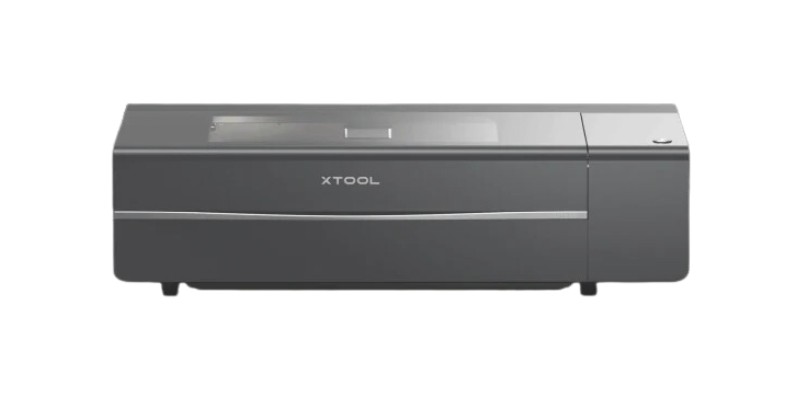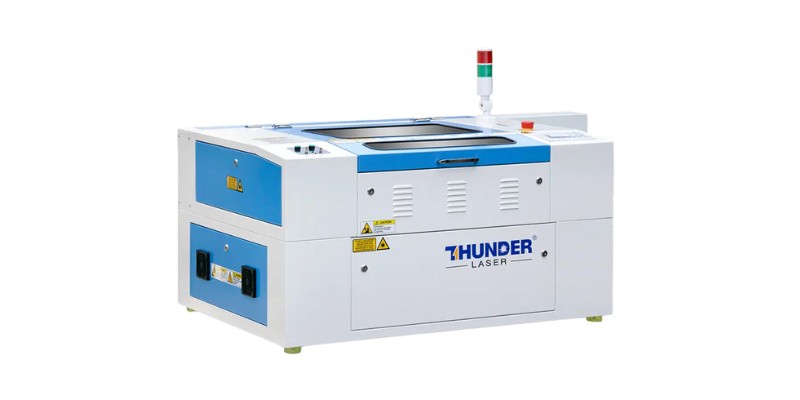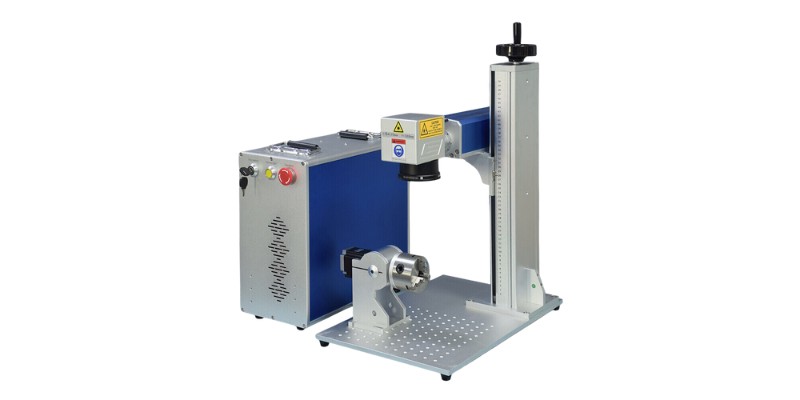The best industrial laser cutters add a layer of automation, flexibility, and precision that entry-level machines can’t achieve – improving the quality of your cuts and the rate at which you can complete them.
In this guide, I’ll walk you through my hands-on experience with the best industrial laser cutters on the market today.
I’d recommend the Glowforge Plus as my top choice overall. It’s pricey, but justified by the level of detail, material compatibility, and ease of use you get in return.
If you’re on a tighter budget, I’ll also step you through the beginner-friendly Flux Beamo 30W, the OMTech 70W for large projects, and the 4-axis functionality of the Snapmaker 2.0.
We’ll consider all of the important factors – like power, cutting capabilities, software compatibility, and maintenance requirements – so you can choose a device that handles all of your needs without overspending.
So if you’re looking to step-up from your laser cutting to something a little more professional, I’ve got you covered.
The Best Industrial Laser Cutters – Reviews
1. xTool P2 – Best CO2 Laser Under $5,000
- Price: Check latest price at xTool here
- Working area: 600 x 308 mm
- Power: 55W
- Laser type: CO2

Pros
Batch processing “Smart Fill” features in XCS make it ideal for small businesses for faster setup
Cuts 20mm wood and acrylic in a single pass
Dual 16MP cameras for easy setup and calibration, and depth sensing
Curved engraving is possible using the second depth sense camera
Supports objects 118” in length with the automatic conveyor add-on for extremely long material sheet cutting and engraving
Cons
Less powerful than more expensive industrial lasers
Industrial laser cutters with 100W+ power come with high price tags, but if you’re looking for a more affordable machine, I recommend the xTool P2.
The P2 offers 55W power while being desktop-friendly. I’ve used it for plenty of different test projects and it’s the BEST CO2 laser in this price range. (You can read my full xTool P2 review here!)
It cuts wood and acrylic up to 20mm thick (it’s not suitable for metal cutting, but you can use it as a metal engraver).
Perhaps its standout feature for industrial use, though, is batch processing. Using the Smart Fill feature in xTool’s XCS software, you can automatically line up a design in the same way on multiple workpieces, reducing setup time.
It’s also ideal for large industrial material sheets for signs and advertising boards. While the P2’s standard working area is 600x308mm, the automatic conveyor feeder accessory and riser base lets you feed through pieces up to 118” in length – even more than the 96” in length in a 4×8’ CNC.
The riser base boosts max height from 2.5” to 8.4”, and also means you can do rotary engraving (you’ll need the rotary attachment as well).
The curved surface engraving was unique to the P2 when it first released, and was the most impressive feature when I used it. There’s two 16MP cameras in the P2, one in the standard laser head to give you a preview for aligning your file. The other is in the corner, and offers a second perspective as a depth sensor. Using this, you can take a kind of 3D scan to get a 3D mesh of the curved surface (like from a bowl, or wooden spoon), and record the different heights at different points.
I tested this out on wooden spoons and was able to create clean and precise engravings. I don’t know of any other lasers with this feature, and it opens a new option for business laser engraving.
Simple the best CO2 desktop laser right now. You can buy this, the rotary, riser base, and the automatic conveyor feeder, and it's still cheaper than a Glowforge Pro.
It's more powerful than competing lasers at 55W, can cut 20mm thick wood in a single pass, and the batch processing and curved surface engraving open up new possibilities for your business.
- Large processing area
- Powerful 55W laser cuts 20mm thick material in a single pass
- 16MP dual cameras autofocus for easy project preparation
- Curved surface engraving in XCS
- Batch processing features
- Can't use all features in Lightburn (but XCS software is really good now)
- Mirrors/lenses may be out of focus from transport and require fixing
2. Thunder Laser Nova – industrial CO2 laser cutter
- Price: $6,900 – $20,000
- Working area: 600x400mm (Nova 24), 600x400mm (Nova 35), 1300x800mm (Nova 51), 1600mmx1000mm (Nova 63)
- Power: 40-60W (Nova 24), 80-100W (Nova 35), 100-130W (Nova 51), 100-130W (Nova 63)
- Laser type: CO2

Pros
Available in various sizes and power options for your industrial needs
Up to 130W power for thicker material sheet cutting at faster speeds
Work on 3D projects
Thunder Laser is known for being one of the highest-quality Chinese laser cutter manufacturers
Cons
Most powerful models are very expensive
Thunder Laser’s Nova series of machines are some of the top industrial CO2 lasers on the market. There are four different models to choose from in this range:
| Model | Power | Working area | Price |
|---|---|---|---|
| Nova 24 | 40-60W | 600x400mm | $7,400 |
| Nova 35 | 80-100W | 600x400mm | $9,900 |
| Nova 51 | 100-130W | 1300x800mm | $12,200 |
| Nova 63 | 100-130W | 1600mmx1000mm | $15,100 |
Although they vary in terms of power and working area, each Nova laser cutter features the same quality features and components.
Each machine has hybrid servo motors that work at high speeds. A 130W Thunder Laser Nova can, for example, cut acrylic at 30mm/s and birch plywood at 80mm/s – this should be fast enough for most industrial operations.
The dual air assist system helps ensure clean and precise cutting, while the smart energy safety board automatically controls the exhaust fan and air pump according to the needs of your work.
Thunder Laser Novas cut woods, acrylics, and leather, and engrave adonized aluminum and painted steel (although it’s not suitable for working on untreated metal surfaces).
Another benefit is that, like the P2, Thunder Laser Novas can process complex 3D projects, thanks to the 3D motorized table that enables different focal distances, and the dual air assist system for switching between different layers. This versatility makes the Nova range suitable for all sorts of different products, from leather patches and acrylic signs to 3D wooden decorations.
You can further enhance your Nova with a variety of accessories, including a H2 laser head for more intricate projects, a 4” laser head for cleaner cuts on thick materials, and a rotary axis.
3. 100W JPT Fiber Laser – Industrial Fiber Laser Engraver
- Price: Check latest price at Amazon here
- Working area: 175 x 175 mm
- Power: 100W
- Laser type: Fiber

Pros
Incredibly fast metal marking
Highest precision – more precise than diode and CO2 lasers
Rotary axis included within the laser package for rotary engraving of popular business products like metal beakers and tumblers
Cons
Expensive for the small working area size
Mainly used for metal engraving – not wood or plastics
JPT is well known for its range of affordable industrial laser machines, such as the M7 MOPA 100W fiber laser.
It engraves with fast speeds of up to 7000mm/s, significantly faster than industrial CO2 lasers. As well as being incredibly fast, the 100 JPT fiber laser is very accurate, with a positional precision of 0.002mm, making it ideal for intricate projects like jewelry engraving.
It has a working depth of 2mm, for engraving rather than cutting – but you can also cut thin metals using multiple passes.
As a fiber laser, this machine is best suited for marking metals, including both non-ferrous metals like aluminum and steel, as well as ferrous metals like gold and silver.
This makes it suitable for a wide variety of applications, including metal surface processing, semiconductors, and electronics.
It has a 300x300mm working area, so it’s suited to smaller projects, although this is a fairly generous size in comparison to other fiber lasers in this price range. The laser also comes with an 80mm rotary module, allowing you to engrave spherical and cylindrical objects, such as rings and aluminum tumblers.
What Makes an Industrial Laser Cutter?
Not all laser cutting machines were created equal, in fact, there’s quite a wealth of variation.
There’s the obvious in that with professional laser cutters there’s an expected level of quality and efficiency that’s higher than more casual models. So, features like higher power, stronger lasers, more robust hardware, and the ability to work with tougher materials are standard.
But then there’s the not so obvious like the different types of laser cutters, such as:
- Gas or CO2
- Crystal
- Fiber
CO2 laser cutters – and the type we’ll be focusing on today – are the most popularly used and manufactured type of commercial laser cutter. They work by using electrically stimulated CO2, which is produced by mixing together other gases, such as nitrogen and helium. These types of lasers typically give a smoother finish, are more affordable, and can engrave and cut through thicker materials than other types.
Fiber laser cutters, on the other hand, are the more affordable type and work by using fiberglass to amplify a “seed laser” for cutting and engraving. They are more energy-efficient and can cut through reflective metals without the worry of back reflection.
Finally, crystal laser cutters are the toughest out of the three. They generate beams by stimulating emissions inside the crystal, which then amplifies the wavelength into a beam. They offer the highest power and can cut through thicker and harder materials, but at a price. They’re the most expensive and also wear down the fastest.
All in all, CO2 lasers support that perfect middle ground between power and price.
Investing in a CO2 industrial laser cutting machine allows you to produce near-exact replicas of your products, increase your business’s versatility, and automate work, helping boost productivity.
Factors to Consider When Buying an Industrial Laser
Type of Laser
CO2 gas lasers and fiber lasers are the most common types used in the industry. Fiber lasers are the best choice for marking metals, while CO2 lasers are better for cutting woods, acrylics, and other non-metals.
However, things are more complicated for the sheet metal-cutting industry since both laser types offer unique advantages. Fiber laser is up to 5 times faster, while CO2 gas lasers cut thicker and with better finish.
Material Thickness
While fiber lasers offer many advantages when cutting sheet metals, they shine when cutting metal sheets under ½”. However, CO2 lasers cut thicker sheets with better finish.
CO2 lasers are also better if you’re planning on laser cutting 1” metal sheets. So, if you’re cutting sheet metals, think about the thickness of the metals you want to cut.
Operational Costs
While dekstop laser engravers have negligible operational costs, running laser cutters for sheet metals is a totally different ball game.
The operational costs can be huge: you’ll have to pay astonishingly heftier bills for a gas laser, as fiber lasers are much more efficient than CO2 lasers. The main operational costs you’ll face with a gas laser are the electric bill and the gas tanks.
We’ve estimated that a CO2 laser’s operational cost for a busy industry can be upward of $70,000 higher than a fiber laser yearly.
Maintenance
Fiber lasers are practically maintenance-free, while CO2 lasers require changing the gas and more maintenance of the optical path.
Also, CO2 lasers require recalculation of their laser settings over time since they’re not as consistent as fiber lasers. High-powered gas lasers also require a 10-minute warm-up before each shift.
Price
Although the price of fiber lasers has reduced slightly in recent years, they’re still more expensive than CO2 lasers.
But if you’re consistently cutting metal sheets under ½” thick, a fiber laser saves you a ton in maintenance, operational costs, and productivity.
Power
Most industry workshops have several laser machines with different powers for different purposes. So, you should balance the laser power with its intended job. For metals, a fiber laser can achieve the same as a gas laser that packs several times the power.
Laser Setup
Easier to use lasers with more intuitive software have shorter setup times and fewer operator errors.
For example, the broad term “autofocus” is used to describe several types of focusing systems. Some laser machines require the operator to use jigs for the right focus, while others use cameras with AI for focusing, saving a lot of time in between jobs.
Other laser buying guides:
- Top laser cutters for metal engraving, marking and etching
- Best laser engravers with rotary attachments
- Best laser cutter for leather crafts
- Best laser cutter for wood crafts
- Best glass laser cutting machines




















